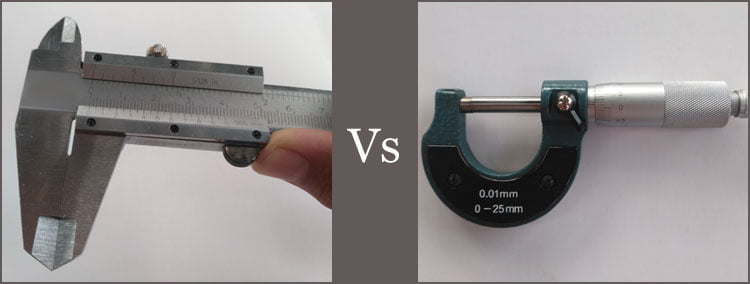Micrometer and caliper are both linear measuring tools that we can encounter easily in machine shops. Both are designed for accurate and precise measurements.
They measure the linear distance of an object such as length, thickness, (inside and outside) diameter, width, depth, etc. As long as you can clamp the object properly, you measure accurately.
These two tools are the right choice if measuring an object that has two sides. If you have only one side, you may want to check dial indicators or test indicators or paint thickness gauge as examples. They are able to measure with no need to clamp the object as the micrometer and caliper do.
Both micrometer and caliper are actually different. When it comes to measuring with a greater resolution, you have to use a micrometer but its measuring range is narrow and you have to be careful when applying the pressure to the object being clamped. A caliper is faster and easier to use and provides sufficient measuring range but the resolution is generally lower than the micrometer.
 Moreover, the differences over the body parts make them distinguishable as well. Caliper is able to measure inside and outside diameter, even depth. In contrast, a micrometer is only able to measure either an outside diameter or inside diameter. So, when you have to check the inside and outside diameter of a bore, you need two units of micrometer.
Moreover, the differences over the body parts make them distinguishable as well. Caliper is able to measure inside and outside diameter, even depth. In contrast, a micrometer is only able to measure either an outside diameter or inside diameter. So, when you have to check the inside and outside diameter of a bore, you need two units of micrometer.
Simply, things such as the measuring range, resolution, ease of use, speed, body parts, and functions are several things that differentiate micrometer and caliper. Let’s get into the breakdown below.
6 Difference Points of Micrometer Vs Caliper
1. Measuring Range
The micrometer has a shorter measuring range compared to the caliper. The common range of a micrometer is 1″ but you can find micrometers on the market comes with a set of several different ranges such as what happens to Mitutoyo 103-907-40. It has 6 different ranges: 0-1″, 1-2″, 2-3″, 3-4″, 4-5″, and 5-6″.
Caliper, on the other hand, commonly has a measuring range of 6″. But there are also available other options with a greater measurement range such as 12″, 18″, 24″ (Mitutoyo 500-506-10), and even 40″ (Mitutoyo 500-507-10).
2. Resolution
In terms of resolution, the micrometer is better than the caliper. Many people use caliper first to check a certain dimension (thickness, diameter, etc), then switch to a micrometer if further accurate measurement needed.
Today’s micrometer has a variety of resolutions such as 0.0001″, 0.00005″, and even 0.1 μm. But the 0.00005″ resolutions are more common and it’s been suitable for many applications. While calipers are commonly 0.001″. Therefore if your micrometers are still 0.001″ resolution, you should upgrade them.

3. Speed
It’s not only about range, but also calipers provide better speed in comparison with micrometers.
In calipers, you just need to slide in order to clamp the object. Apply the thumb scroll (if available) to give pressure, and take the reading. Micrometer, on the other hand, requires you to rotate the thimble. Surely it’s not as quick as the caliper does.
Sliding for an inch is easy for a caliper. But things are different with a micrometer, moving linearly for an inch requires several thimble rotations which means more works and time. In this case, we can conclude that that using a caliper is way faster than a micrometer.
Even further, when rotating the micrometer’s ratchet to apply pressure to the object, you have to make it carefully. A tiny slide can mislead the reading. If you rotate the ratchet too quick, it can overpressure and excessively give pressure to the object’s surface.
4. Ease of Use
Talking about the ease of use between the micrometer and the caliper, in our opinion, using a caliper is easier than a micrometer. As said before, applying pressure with a thumb scroll is simpler compared to applying pressure with the ratchet.
5. Body Parts
Both micrometer and caliper have their parts to clamp the object to be measured. But the differences can be observed as a micrometer only provides 2 parts (anvil and spindle), while a caliper commonly provides 4 parts (2 internal jaws and 2 external jaws). These parts lead to how versatile they are to perform a linear measurement.
The micrometer’s anvil surface contour is commonly flat. But you can find it in other models such as tubular, ball, spherical, etc. Ball and spherical anvils are such as those in reloading micrometers (micrometer designed for reloading). While caliper has two surfaces on its jaws: flat and pointed. Other calipers can come with other shapes as well.
In terms of applying pressure to the object, a micrometer has a part called a ratchet. While a caliper has a part called a thumbscrew. The differences lie in how we operate them. Ratchet rotates while thumbscrew rolls on.
For the scale, especially the mechanical micrometer model has a rotatable thimble that contains a scale where you take the readout. The digital micrometers, on the other hand, are sometimes available with either a thimble scale or none. In comparison with a caliper, it (both vernier, dial, and digital calipers) has its scale connected to the jaws and slides together.
6. Functions
Since calipers and micrometers have different body parts, the measurement functionality of both is different as well. Calipers have several functions while micrometers only have a specific function.
Todays’ calipers come with full 4 jaws that mean able to measure inside and outside diameter at the same time in a single caliper. Plus, it also comes with a depth rod to measure depth. In contrast, a micrometer only comes with an anvil and a spindle that means only able to measure outside diameter. If you need to measure the inside diameter, you need another one that has special anvil and spindle shapes.
Simply, in terms of measuring diameter, a caliper is able to perform internal and external diameters. While micrometer is only able to perform either outside or inside diameter. In terms of depth measurement, you can do it with a caliper but you need another micrometer that specializes to measure depth.
7. How They Work
For magnification, micrometers employ the contribution of the threaded spindle, while the calipers use the sliding frame. Therefore, the way we use micrometers is by rotating. And we slide the frame while using calipers.
On the other hand, the digital, in contrast, is quite different. They use electronic components. The digital micrometer employs cylindrical capacitive components to convert the electric charge into numbers. While the digital calipers manipulate the charge by using rectangle capacitive components that slide over the main scale.
Micrometer Vs Caliper: Points to Conclude
In summary, we can merge the points of micrometer vs caliper into the following table below. Even further, we compile them into an infographic as well. Click the following micrometer vs caliper infographic to open in the new tab!
| Micrometer | Caliper | |
|---|---|---|
| Range | 1" | 6" |
| Resolution | 0.00005" | 0.001" (0.0005" for digital caliper) |
| Speed | Slower | Faster |
| Functions | Specific: OD or ID or Depth | More: OD & ID & Depth & Step |
| Body Parts | - To clamp: anvil & spindle - To press: Ratchet | - To clamp: 2 outside jaws & 2 inside jaws - To press: Thumbscroll |
| Ease of Use | Easier | More careful |
| How It Work | Threaded spindle | Sliding frame |

